Why Are Starlings a Problem?
In North America, European Starlings are undoubtedly a problem. They are an invasive species, they shouldn’t be there and they don’t form a natural part of the local ecosystem.
But here in the UK starlings are one of our native birds, declining in numbers, but still a fairly common sight in our gardens. So why do people view them as a problem?
Flocks
The primary cause of starlings unpopularity probably comes from their gregarious, sociable nature.
Starlings rarely come to the party alone, they bring a crowd. Though during the spring and early summer starlings tend to live in smaller, loose colonies come the autumn, juveniles start to form large flocks, And in winter migrants from northern and eastern Europe swell the numbers of our native starlings, arriving in huge flocks of thousands of birds.
This of course is when we get the chance to see the amazing sight of starling murmurations. If you’ve never seen one of these spectacular aerobatic displays live they are well worth seeking out.

Living in flocks has many advantages for starlings, protection from predators and winter warmth are just two. But for humans, the arrival of a whole flock of starlings can be more challenging.
Noise
Starlings are chatty, noisy birds. Personally, I enjoy their constant squabbling and squawking. But for anyone who prefers a little more tranquillity in the garden a flock of starlings is going to ruin your day.
Eating You Out of House and Home
Starlings are enthusiastic guests at our bird feeders and because they travel in groups and have evolved to feed quickly they can seem to decimate the contents of your bird feeders in record time. Leaving nothing for other birds.
They are not being greedy, it’s just what they do. But still, things can quickly start to get expensive if you don’t manage the situation.
Taking Over
Though starlings don’t defend a breeding territory, like robins, they will fight other starlings and other species for food.
They are a chunky bird, and size combined with numbers and aggression may lead you to feel that a healthy starling population could drive smaller birds out.
Poop-Tastic
If you have a starling roosting site in or near your garden droppings can certainly become a problem.
Droppings from hundreds or even thousands of birds can cause a mess or even possibly a health risk if they are fulling directly onto people or animals.
Starlings like to roost in sites with plenty of branches or ledges. So manmade structures like piers or multi-story car parks are favourites, as are large trees and groups of conifers.
The problems caused by larger flocks of starlings are short-lived though. Arriving just before Christmas in most years they usually start to disperse by February and colonies return to a more manageable size.
Starlings and Conservation
Though still, a pretty common sight in our gardens starlings in the UK are in dramatic decline. So even if from time to time, they can be challenging birds to have around, there are legal and ethical reasons to consider before we try to discourage them from our gardens or bird feeders.
Why are Starlings in Trouble?
Estimates vary, but according to RSPB studies numbers have decreased by 80% in the past 50 years. The British Trust for Ornithology reports that there are now as few as 1.6 million breeding pairs here in the UK.
For this reason, starlings are now red-listed for conservation purposes and protected under the Wildlife and Countryside Act 1981.
But why are numbers declining so sharply? Why are starlings in trouble?
Nesting Sites
Like several other bird species, starlings like to nest in cavities or holes. These could either be in mature trees or in manmade structures.
Suitable nest sites are getting more difficult to find. We are cutting down mature trees and modern construction methods mean that the cavities in eaves and soffit boards that starlings love to nest in are becoming scarce.

Starlings are very successful breeders with over 70% of eggs laid successfully fledgling. But without suitable nest sites, there’s no chance for the eggs to be laid in the first place.
Food
Like robins and blackbirds, starlings eat mainly insects and invertebrates in summer and move on to seeds and berries in the autumn and winter months. Baby starlings rely entirely on invertebrates for food.

Although they can and sometimes do fly catch, starlings mainly feed on the ground. They eat a wide range of insects but their favourite food is leatherjackets, the larvae of the crane fly.
Leatherjackets and many of the other insects favoured by starlings and their young live in short grass. So agricultural land with permanent pasture was a prime feeding ground. The dramatic decrease in permanent pasture, monoculture agriculture and the increased use of pesticides has led to a decline in invertebrate numbers of up to 75%.

With up to 75% of the starlings’ natural diet removed they, along with many other small bird species, hedgehogs and other mammals and amphibians and quite literally starving to death.
I guess this is why I’d be reluctant to turn them away from my garden, however annoying I might find them.
Starlings and The Law
European starlings are protected in the UK under the Wildlife and Countryside Act 1981. Because the species is in decline it is an offence to:
- Intentionally kill, injure or take a starling.
- Intentionally take, damage or destroy an active nest or its contents.
So whilst it’s illegal to trap or harm starlings, or interferes with nests in any way there is no penalty for discouraging roosts, and we’ll look at safe and eco-friendly ways of doing this if you have to.

How To Keep Starlings Off Your Bird Feeders - If you Must
We hope we have persuaded you that starlings deserve feeding too. But if you are still keen to put them off, even if it’s just so the other birds can get a look in, here are a few things you could try - along with a couple of strategies that - in our opinion, just don’t work.
Starling Deterrents that Don’t Work Well
Starlings seem to be unwanted birds in quite a few gardens. So the internet is full of products and DIY strategies for keeping them off your bird food. You could spend a lot of time and money on things that probably won’t work that well.
Starling Proof Bird Feeders
Because their natural diet consists mainly of invertebrates starlings tend to prefer to feed on the bird table or on the ground. They will however happily have a go at hanging feeders if they seem to contain a tasty meal.

So there are lots of starling-proof bird feeders about. You could try a caged feeder, a tube feeder, an upside-down suet feeder, enclosed mealworm feeders, feeder guards and mesh. Some of them will indeed exclude starlings,
The trouble is that, unlike pigeons, starlings are not very big birds. So anything that keeps starlings off your bird food may allow very small birds in, but it will also exclude other mid-size birds which you may not consider pest birds, such as robins or blackbirds.
The other point to mention is that starlings are ingenious so quite a few of the devices on the market just don’t work at all.
Choosing Bird Food that Starlings won’t Eat
Starlings are not picky eaters. Mealworms, suet balls, kitchen scraps. Sunflower hearts, good quality seed mix and softbill mix will all go down well.
They are softbills, so starlings will struggle with hard grains and seeds that pigeons, doves and game birds enjoy. And they are said to struggle with Nyjer seed.

But you can see from the list above that trying to remove foods that are attractive to starlings is going to leave your bird table pretty bare for most of your other species too.
Starling Strategies Worth A Try
Starlings and determined and ingenious. Keeping away from your bird food altogether is probably an impossible dream.
And starlings are starving to death so they do need feeding too.
But there are a couple of tactics that you can try which will give your other garden birds a fair chance at the feeding station too.
Staggered Meal Times
Starlings are not the earliest birds up and about in the mornings, they also tend to head off to roost pretty early in the evenings.
So food put out in the early morning, or at dusk, will often provide a meal for other species.
You’ll also find that starlings don’t tend to hang around all day, in the way that pigeons do. They descend, eat everything in sight, then move on.
So if you put a limited amount of food out for the starlings, wait for them to finish up and leave, then add more for your other birds this could work too.
Social Distancing
Spreading out your feeders through different areas of the garden is a good idea for all your birds and starlings are no exception.
Starlings tend to descend as s group on the most obvious feeders in your garden. So having other feeders spread around the place in less obvious areas will give everyone room to feed in peace.
Take Cover
As starlings natural feeding grounds are short grass and pastureland it’s no surprise that they will prefer to feed on the open areas of your lawn rather than in amongst the undergrowth.
If you watch the birds in your garden feeding you’ll know that many species are more than happy picking through the leaf litter in borders and under hedges.
So food sprinkled on the ground under hedges and in borders, or feeders hung in well-covered areas, are more likely to be ignored starlings and taken advantage of by other birds.
Dealing with a Roost
A gang of starlings visiting your garden for food, or a couple of nesting pairs, shouldn’t really be a problem and might actually be very welcome.
A winter roost of hundreds or thousands of birds in your backyard, on the other hand, could be a bit of a challenge.
The first thing to note is that it’s not very likely to happen. When starlings were more populous, large winter roosts and murmurations in urban areas were common. I remember seeing them regularly in Coventry city centre as a child (I used to find them quite scary at the time!). But now, large urban roosts and murmurations are rare and the huge winter flocks tend to stick to more remote rural areas.
Secondly, they won’t be there long. They tend to arrive just before Christmas and leave in February. So if you did get a flock roosting in your garden, maybe you could go with it for a couple of months and just enjoy the amazing natural spectacle.
If you do need to move them on the RSPB advises playing a starling distress call below the roosting site as they come into land. This done on a couple of consecutive evenings should convince them to go elsewhere.
Starlings Need Feeding Too!
We hope we’ve convinced you that although they may not be your favourite bird, starlings need feeding too. In fact, they are probably more in need of the bird food you offer than some of the more attractive visitors to your garden.
Starlings in the UK are in trouble and they need our help. Hopefully, we’ve provided some ideas on how you can welcome them into your garden, without breaking the bank or depriving your other wild birds of a meal.
Thanks for reading! If you have suggestions or questions we would love to hear them. Leave us a comment below.
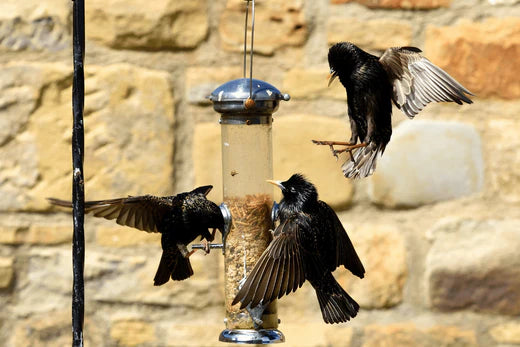


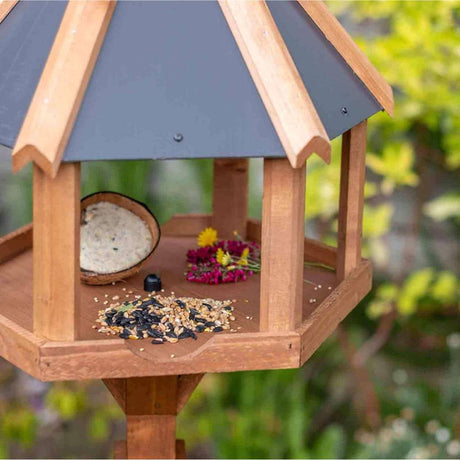

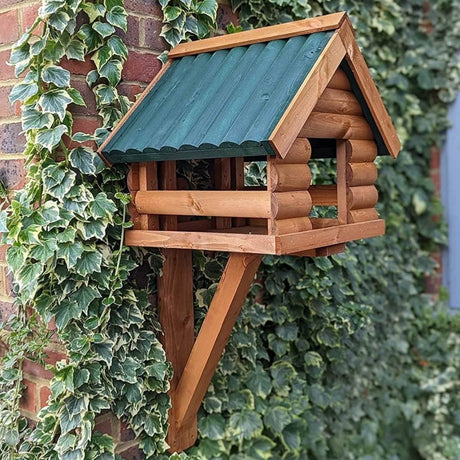
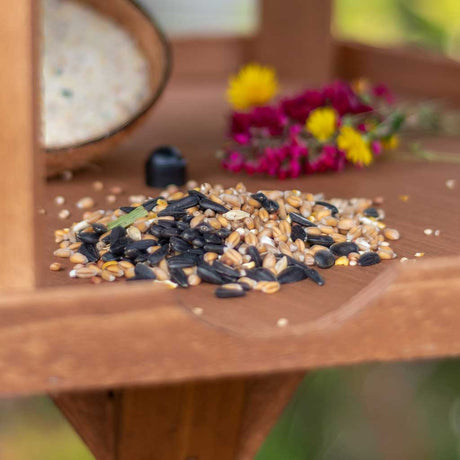
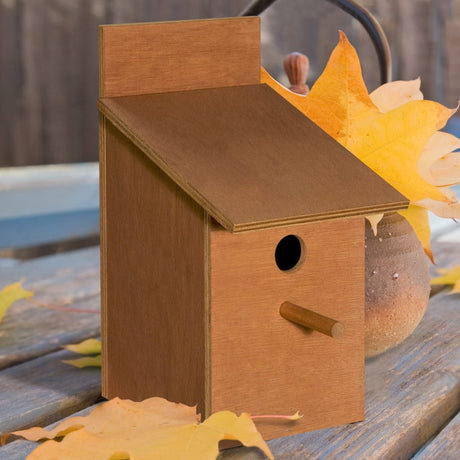

33 comments
How do you stop the starlings from eating everything that is put out. I have a family of sparrows that were hatched in my hedge about 3 years ago so they are here/ I have lots of little birds that have been quite happy eating what input out. The last month there has been a barrage of starlings and they pick on the little birds and will not let them eat. I am not putting food out as much but the little birds sit on my fence waiting. I know they all like to eat but the starlings are just bullies. What can I use that is starling proof or another food to distract the starlings
Starlings Beautiful birds cheeky songsters but a lot of what i have just read does not hold i get descended on by by around 100 birds and their young they quite happily take over the feeders hanging in the Hawthorn (along with the Blackbirds almost as bad) small bird feeders are defeated very quickly the main proble3m is there is never enough space between the outer cage and the inner feeder . the Upside down suet feeders dont work they quite happily do a woodpecker and hang upside down underneath eating away . Noisy little blighters Oh and they keep trying to get at my Gooseberries and get trapped in the mesh of the net talk about a voice when you try the free them from the netting getting pecked to bits as well then have a dump on you just as you let them free there’s grattitude for you .
Thank you for the article, I have too many starlings which are frightening off the other birds – I am pleased you mentioned using a starling distress call but I would say not Amazon, please. Not again. Not for everything. A starling distress call can be found free on Youtube.
I am sorry for the starlings but they are not welcome in my back yard, Ive had to wash the plants in the obelisk as they sit making a mess on it, I let them have a bit then the water spray comes out, there is plenty of scrubland around my way where they can find live food not treat my yard as McDonalds
Really useful. You have persuaded me to keep putting out the fat balls for the starlings who I now realise need it most, even though the do seem so abundant! Like the idea of spreading feeders around and hiding food in other places for all my other lovely birds
In my garden non of the suggestions mentioned work, staggering feeding time starlings just come down every time and eat the lot no matter how many times during the day leaving nothing for the other birds, feeders they raid till they are empty the feeders with a cage round don’t work the cage around the feeders isn’t wide enough and they just stick their head through and still get the seeds night time works but by then most of the other birds have gone to bed too if you like starlings please take mine
Filled my bird feeders one afternoon, the next morning three were completely empty, so about twenty starlings were all trying to feed off the others when I looked out at 6.45 this morning. Some others were on the lawn, as much as I love birds the starlings are getting on my nerves. Don’t seem to see many of the other birds that used to come, Blue Tits, Robins , Bullfinches , to name but a few . Starlings may need feeding but so do the others, they are greedy , fight each other . The comment by someone in the part about starlings that they are not early risers, and roost early, mine seem to be early, all day, and evening. It also said they are gone by February so why have I still got them decimating my feeders. I wouldn’t hurt them but am definitely going off them and wish they’d go away and not come back. I am thinking of discarding my bird feeder because of them, which isn’t fair on the other birds. I don’t feel sorry for them at all. I’m sorry if you think I’m wrong but have had enough of them
I am very happy to have a pair of starlings visiting my feeders this year. I haven’t seen any here for several years. They are enjoying my suet pellets
Thankyou for this very informative article. They are a bit of a nuisiance but Im gonna try and put up with them !
We live in Ceredigion and our village is surrounded by farmland, and every winter we have a flock of Starling in the garden to feast on the bird feeders. Yes they are noisy and very messy, but the smaller birds seem happy to share, and it’s good to know that we’re doing our bit for conservation.
I put out food that is up for grabs by all my visitors but I also have a few caged seed and peanut feeders for my all year round tits and robins.
The starlings in my garden devour all the bird food in a matter of a few hours… none of the other small species get a look in. They squabble and fight around the feeders with each other even though there is plenty of feeders. I moved the feeders to the inside branches of a hedge I cut back… this doesn’t stop them. They eat all good and manage to raid ‘squirrel proof feeders. … one exception is Niger seeds… bullfinches have stopped coming to the garden now. On some days I have removed the feeders but when I return them they flock down again fighting with each other over the food. I don’t hate starlings, just don’t like the greediness and fighting within the group whilst feeding. Any other ideas apart from above that I have already tried. Thanks … Dawn ?
I came here looking for ways to discourage starling from ravishing the bird feeders and I’m leaving feeling sorry for them and for UK’s loss. I am going to try staggering feeds and placing a couple other feeders away from the main group. Thank you for this article.
Thanks for your advice I have a large group of starlings visiting my garden At first I thought of deterring them but then they grew on me Watching them feed their young then as they got older all the squabbling over food is amusing to see My advice to anyone wanting to get rid of starlings is to look at an adult bird through binoculars They are truly a beautiful bird
So enjoyed your article I love starlings too.
Yes they do eat a lot and love mealworms which cost a fortune but to watch the adults feeding the babies is wonderful! I am an OAP but they are worth every penny for the pleasure they give – they feed in my backyard and all the other birds feed at my front!
Hi, its May now & my garden is full of starlings so many that the blackbirds, bluetits & robins have left, with a much smaller number than usual of house sparrows remaining. The starlings are there all the time early morning through to night not allowing the other birds a look in re food. The neighbours are also now complaining of the noise from them which is relentless. I understand they need feeding too, but not only will is my bank balance not enough for the amount they get through, I want the other birds to be able to feed to. If I stop feeding all together for a bit will they move on?